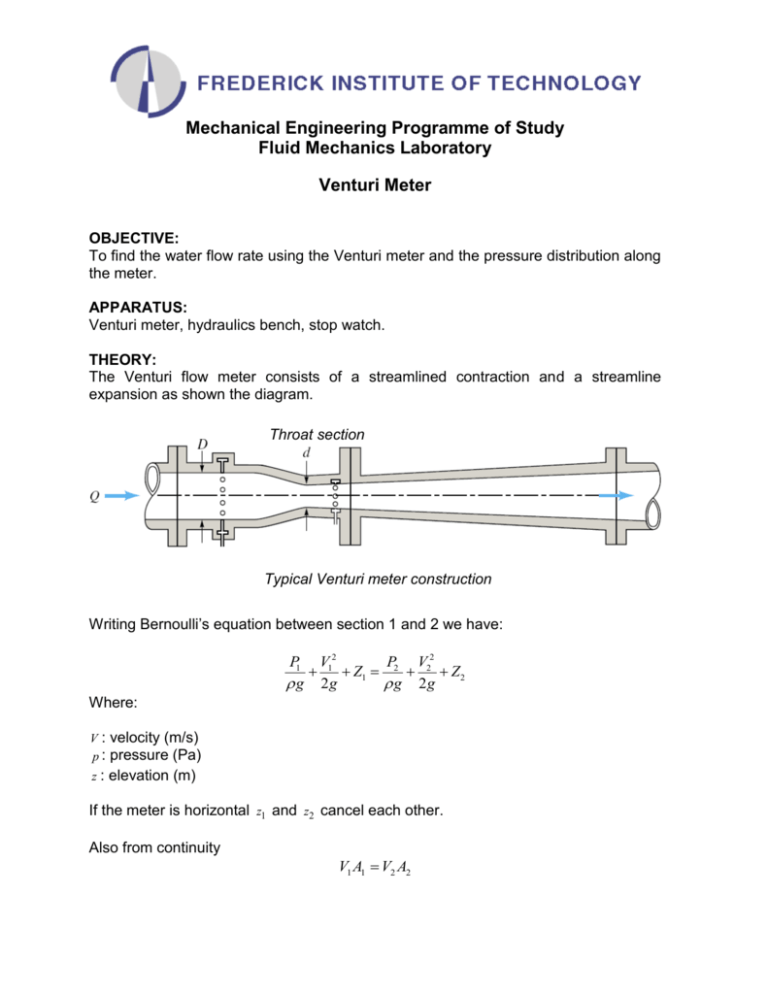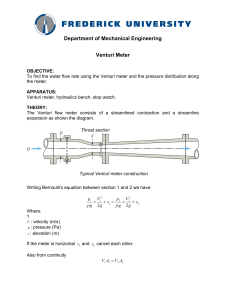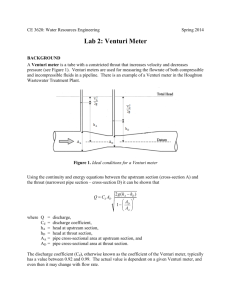Venturi Meter Lab: Flow Rate & Pressure Distribution
advertisement

Mechanical Engineering Programme of Study Fluid Mechanics Laboratory Venturi Meter OBJECTIVE: To find the water flow rate using the Venturi meter and the pressure distribution along the meter. APPARATUS: Venturi meter, hydraulics bench, stop watch. THEORY: The Venturi flow meter consists of a streamlined contraction and a streamline expansion as shown the diagram. Throat section Typical Venturi meter construction Writing Bernoulli’s equation between section 1 and 2 we have: P1 V12 P V2 Z1 2 2 Z 2 g 2g g 2g Where: V : velocity (m/s) p : pressure (Pa) z : elevation (m) If the meter is horizontal z1 and z2 cancel each other. Also from continuity V1 A1 V2 A2 Where A is the area. Solving for V2 we have: 2 p1 p2 / V2 A 1 2 A1 2 The pressure p equals p gh 2 g h1 h2 V2 A 1 2 A1 2 The volumetric flow rate is then given by: Q V2 A2 i.e. A2 Q A 1 2 A1 2 2 g h1 h2 This equation is valid for incompressible and inviscid fluids so it can be used only at high Reynolds numbers. At low Reynolds numbers the coefficient of velocity C V must be applied: Q C Qideal C A2 A 1 2 A1 2 g h1 h2 2 The flow coefficient K is then defined as: K C A 1 2 A1 2 So that Q KA2 2 g h1 h2 The flow coefficient can be obtained from the following figure. In this figure d is the diameter of the throat section and D the diameter of the inlet (section 1). is the kinematic viscosity of water. PROCEDURE: A schematic of the Venturi meter is shown on the diagram at the end of the procedure. The inlet diameter equals d – 26 mm and the throat diameter d = 16 mm. The pressure along the meter is obtained using the 11 pressure taps at the locations shown on the diagram. The water flow rate can be adjusted using the valves on the hydraulics bench. For the flow rate examined make sure that the pressure level in the manometer tubes is within the range of their scales. If not, add air pressure in the common manifold using the air pump provided until the manometer levels are within the required range. The mass flow rate can be measured using the hydraulics. METHOD: For two different water flow rates do the following: (1) Obtain the pressure distribution along the Venturi meter. (2) Using the inlet pressure (tap No.1) and the throat pressure (tap No.4) calculate volumetric water flow rate using the formula derived in theory. (3) Compare the volumetric flow rate to the actual flow rate as obtained using the hydraulics bench measuring tank. (4) Plot the non-dimensional pressure distribution along the length of the Venturi meter against the distance from the inlet cross section. Plot results from both flow rates on the same graph. The non-dimensional pressure is defined as: hn h1 U t2 2g Where Ut is the velocity at the throat of the Venturi meter as obtained from the actual flow rate of the water. (5) Plot on the figure of step No.(4) the ideal pressure distribution which is found by considering Bernoulli’s equations as: 2 hn h1 At At U t2 A1 An 2g Where A is the cross-sectional area. 2 Comment on your results. Is the actual pressure distribution different than the ideal one? Explain why. Is the exit pressure equal to the inlet one? If not, explain. D Tap No. 1 2 3 4 5 6 7 8 9 10 11 Distance of Tap from tap No.1 (mm) 0 44 56 70 84 97 111 128 143 158 203











